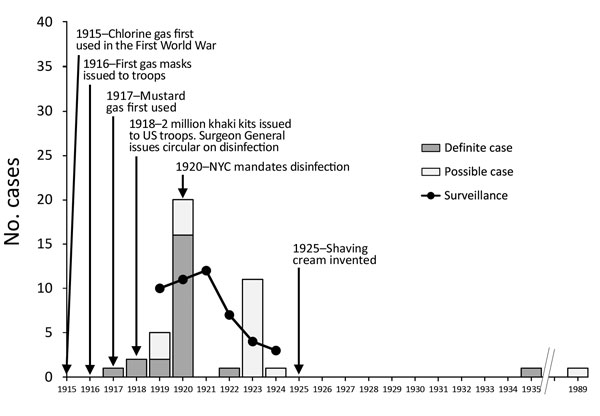Volume 23, Number 5—May 2017
Historical Review
Anthrax Cases Associated with Animal-Hair Shaving Brushes
Figure

Figure. Timeline of use of shaving brushes and anthrax, 1915—1989. Case totals for the United States were reported in 1924 and 1930 and included 2 cases for 1927 through mid-1929, but the exact year of occurrence was unspecified (5,6). Data for English-language case descriptions were obtained from a systematic review of systemic anthrax cases published during 1880–2013 (7). Individual cases were reported from the United States, with the following exceptions: 1917, 1 definite case from England; 1918, 2 definite cases from Canada; 1920, 1 definite case from England; 1924, 1 possible case from South Africa; 1935, 1 definite case from Trinidad (8); and 1989, 1 possible case from India (9).
References
- Carey HW. Anthrax from the shaving brush and primary anthrax meningitis. Am J Med Sci. 1920;159:742–6. DOIGoogle Scholar
- Symmers D, Cady DW. Occurrence of virulent anthrax bacilli in cheap shaving brushes. JAMA. 1921;77:2120–1. DOIGoogle Scholar
- Smyth HF. Anthrax–a continuing and probably increasing hazard of industry. Am J Public Health (N Y). 1924;14:920–4. DOIPubMedGoogle Scholar
- Smyth HF, Cheney VS. Anthrax as an occupational disease. Am J Public Health Nations Health. 1930;20:155–60. DOIPubMedGoogle Scholar
- Katharios-Lanwermeyer S, Holty JE, Person M, Sejvar J, Haberling D, Tubbs H, et al. Identifying meningitis during an anthrax mass casualty incident: systematic review of systemic anthrax since 1880. Clin Infect Dis. 2016;62:1537–45. DOIPubMedGoogle Scholar
- Pawan JL. A case of anthrax in Trinidad due to an infected shaving brush. J Trop Med Hyg. 1935;•••:170.
- Khanna N, Gokul BN, Ravikumar R, Chandramuki A, Gourie-Devi M, Aroor SR, et al. Successfully treated primary anthrax meningitis. Indian J Pathol Microbiol. 1989;32:315–7.PubMedGoogle Scholar
- Hubbard DS. Anthrax in animal hair. JAMA. 1920;75:1687–90.
- Shaving brushes anthrax carriers. The New York Times. 1919 Aug 18: 1 (col 1).
- World Health Organization. Anthrax in humans and animals, 4th ed. Geneva: The Organization. 2008. p. 18–20.
- Stein CD. The history and distribution of anthrax in livestock in the United States. Vet Med. 1945;40:340–9.
- Animals and Animal Products, 9 C.F.R. Sect. 95.3–95.8 (2016).
- World Organisation for Animal Health. Anthrax. Terrestrial Animal Health Code. Chapter 8.1 Paris: The Organisation; 2016.
Page created: April 14, 2017
Page updated: April 14, 2017
Page reviewed: April 14, 2017
The conclusions, findings, and opinions expressed by authors contributing to this journal do not necessarily reflect the official position of the U.S. Department of Health and Human Services, the Public Health Service, the Centers for Disease Control and Prevention, or the authors' affiliated institutions. Use of trade names is for identification only and does not imply endorsement by any of the groups named above.